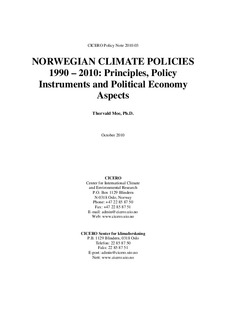| dc.description.abstract | Norwegian climate policies with a focus on the mitigation of Green House Gas (GHG) emissions over the last twenty years, the period of the existence of CICERO, is critically reviewed and analysed in this policy paper.
Best practice principles and policy instruments as recently set forth by the IEA, the OECD and the Stern Review are reviewed along with political economy aspects of the structural social and economic changes caused by ambitious climate policies.
Important Norwegian Official Research Papers and independent foreign Peer Review of Norwegian climate policies are reviewed over the period 1991-2009 and compared with the recent international best practice guidelines. The Norwegian analyses and policy recommendations compares fairly well. Cost-efficiency and effectiveness are main policy principles, but policy instruments should also be assessed on the basis of adaption and compliance, their ability to cope with uncertainty, their effectiveness in stimulating the innovation of climate-friendly technologies, and the facilitation of international cooperation.
Norwegian GHG-emissions increased by some 2 per cent from 1990 to 2009 while GDP per capita grew by more than 52 per cent over the same period, implying significant improvements in emission intensities. Some 70 per cent of Norwegian emissions are now covered by CO2-taxes and an Emission Trading System (ETS), the two main market based policy instruments, but policies are not cost-efficient across economic sectors du to political economy concerns.
Lessons for future policies are set forth at the end of the paper, and three of these are:
-They should be presented more clearly as measures to buy insurance against the risks of climate change in an uncertain world; -One should identify more precisely the structural consequences of ambitious climate policies, but also the future possibilities for "green growth"; -Assess policy instruments in terms of cost-efficiency and effectiveness, but also their potential to minimize political resistance so as to give clear and credible future signals to the household and business sectors. | nb_NO |
